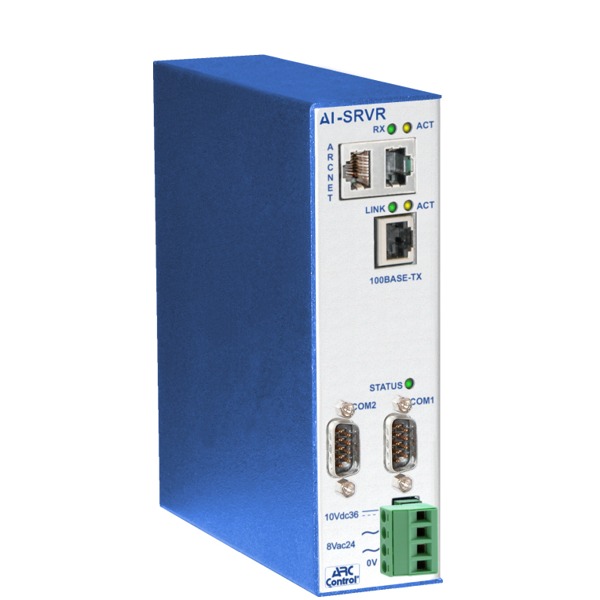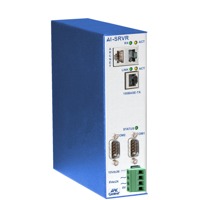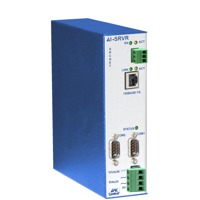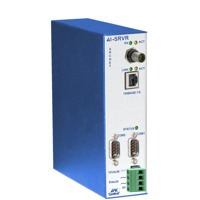AI-SRVR Series - ARCNET Server to Ethernet Client
The AI-SRVR allows for connectivity between an ARCNET network and an Ethernet network giving a client on the Ethernet side access to nodes on the ARCNET side. The unit's role as an ARCNET server is to execute communication requests from an Ethernet client. Any number of Ethernet TCP/IP clients can initiate requests to any node on an ARCNET network. This device will receive ARCNET packets and send the data to Ethernet clients or reverse the process for packets received from Ethernet.
Both ARCNET and Ethernet are data link technologies with varied medium access methods, frame sizes and link layer protocols. With Ethernet, the most popular transport layer protocol is TCP/IP, but ARCNET is more commonly found in embedded applications that do not use TCP/IP. ARCNET also does not employ a universal application layer so it is best to query ARCNET by examining raw packets. It is up to the Ethernet client to interpret the meaning of the raw packets. It is up to the Ethernet client to interpret the meaning of the raw packets. This approach enables any ARCNET network to be queried by an Ethernet client regardless of the application layer protocol being used with ARCNET.
Configuration of the AI-SRVR is achieved through an EIA-232 serial port. The Ethernet IP address and ARCNET node address are set in this fashion. Once configured, a resident web server can be accessed to determine the operational status of the AI-SRVR.
It's possible for an ARCNET network to consist of 255 nodes. Node address "0" is reserved for broadcast messages. The AI-SRVR will consume one address and will participate in the token-passing protocol on this technology's network. This product can operate in promiscuous mode and, therefore, can monitor all ARCNET traffic. It reserves 256 mailboxes for the maximum number of nodes plus one for broadcast messages. Each mailbox has a first in-first out (FIFO) memory whose depth can be set. A mailbox captures the packet data originating from a source node. Depending upon its configuration, it will capture all packets originating from those nodes of interest. The packets will be stored in mailboxes corresponding to source node addresses. The two methods of receiving are the polling and the automatic forwarding modes. The polling mode enables the Ethernet client to continually check mailboxes for data. If not polled in time, data will be lost. The automatic forwarding mode allows packets in mailboxes to be automatically forwarded to the requesting Ethernet clients.
The Ethernet side of the AI-SRVR acts as any other 10/100 Mbps Ethernet TCP/IP station requiring an IP address assignment. An Ethernet client can write data to the ARCNET network by simply specifying the ARCNET destination address and appending the data to be sent. Numerous Ethernet clients can do the same. The AI-SRVR will receive the requests and execute the writes using its own ARCNET node address as the source address. It will process requests from Ethernet clients in the order they are received. To facilitate this process, Contemporary Controls provides a DLL for use with Windows 2K/XP clients.
The AI-SRVR can also operate in the "AI-PROXY" mode. When used in AI-PROXY manner, the unit allows ARCNET devices on separate networks to communicate directly over an Ethernet network. One AI-SRVR node is needed for each ARCNET device because each AI-SRVR node functions as a "proxy" for one ARCNET device. Basically, it sends received ARCNET packets over the Ethernet network to an appropriate AI-SRVR for re-transmission on its ARCNET network. This allows ARCNET nodes on separate ARCNET systems to communicate over an Ethernet network.
Because the AI-SRVR-1 can perform as a proxy for only one ARCNET node, the AI-SRVR-8 has eight internal nodes so that it can act as a proxy for up to eight ARCNET nodes. The AI-SRVR-1 and the AI-SRVR-8 can also be used together—for example, to add one remote ARCNET node to an eight node ARCNET network. Multiple AI-SRVR-8 units are used when more than eight ARCNET nodes are represented.
This product has the same power connections as the AI Series of hubs. It can be powered from a wide range of low-voltage AC- or DC-power sources and provisions exist for redundant power connections.





